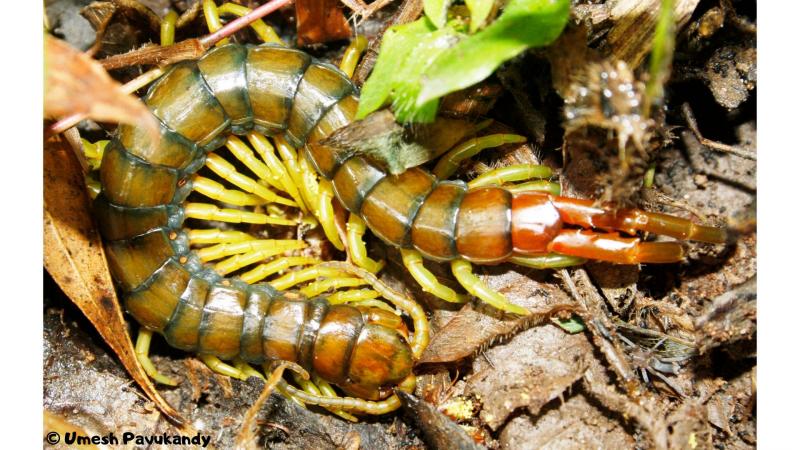
About 250 million years ago, the present-day continents broke away from the supercontinent Pangaea, shaping not only the globe as we know today but its biodiversity too. The Gondwana landmass, comprising today's Africa, Antarctica, Australia, India, Madagascar and South America, started to separate about 180 million years ago. Living organisms were impacted by this moving of landmasses, where some dispersed and some of them began evolving as separate groups. One such ancient taxon is the centipede, a kind of predatory arthropods.
In two recent studies, researchers Dr Jahnavi Joshi and Dr Gregory D. Edgecombe, from the Natural History Museum, London, have uncovered the evolutionary links between the different species of centipedes dating back to Gondwana. The two studies, published in the journals Invertebrate Systematics and BMC Evolutionary Biology, were funded by the Royal Society-SERB Newton Fellowship.
The researchers studied centipedes belonging to genus Ethmostigmus that are distributed across Africa, India, Southeast Asia, Australia, Melanesia and Polynesia. There are about 19 known species of these centipedes. In their studies, the researchers collected 25 specimens of centipedes from 15 regions in the Western Ghats and the Eastern Ghats of India. Using genetic sequencing methods, morphological measurements of the samples and their geographical information, they traced the relationship between species and their evolution over time and geographies.
The analyses found that the specimens showed considerable variations in their genetic makeup. The statistical analysis of the data pointed to the existence of five species within peninsular India, all sharing a common ancestor. The researchers then compared these specimens with the available morphological descriptions of centipedes from peninsular India. They found that two of these species matched the description of known species, and one of them, Ethmostigmus tristis (E. tristis) from the Eastern Ghats, was rediscovered after 130 years.
"The remaining three species from the Western Ghats could not be assigned to any named species," say the researchers, who have now described them as new species. They are named Ethmostigmus agasthyamalaiensis after the Agasthyamalai hills, E. sahyadrensis after the Sahyadri hills and E. praveeni after the ecologist, Praveen Karanth, in recognition of his work on Indian biogeography.
New species could evolve either through a vicariance or dispersal event. In a vicariance event, plants and animals inhabiting a region get separated due to barriers like drifting continents and then start evolving independently. On the other hand, during a dispersal event, organisms can cross pre-existing geographical barriers like oceans, then start evolving in the new land. The role of vicariance and dispersal events are important for explaining the patterns of distribution of species that exist today.
Among the arthropods, centipedes are one of those taxa that are known to have limited dispersal ability. Fossil records show that they are ancient creatures, some dating as far back as 418 million years. Hence, they are good candidates for figuring out how dispersion and vicariance have shaped their lineages.
Based on the genetic data of sampled specimens and through fossilized specimens, the researchers traced when the five species evolved in India. They found that the species belonging to Ethmostigmus in peninsular and North-East India first separated from their African and Australian counterparts as a result of two vicariance events. These were initiated around 99 million years ago, which corresponds to the break-up of India from eastern Gondwana. Then, about 72.2 million years ago, peninsular Indian species started evolving due to dispersal events.
The study sheds light on how geological and geographical events have shaped the evolution of India's centipedes. However, the understanding of biogeography and the diversification of ancient terrestrial arthropods in peninsular India is limited.
“India is home to three biodiversity hotspots and harbours an amazing array of biodiversity. Unfortunately, there is a substantial part of the arthropod biodiversity, in particular, that is poorly understood and documented,” says Dr Jahnavi Joshi. She is an evolutionary biologist whose interests lie in understanding the evolutionary, geological and ecological factors that shape the diversity patterns of arthropods, particularly in India. “The new species descriptions in centipedes, also in other taxa, highlights our poor understanding of arthropod diversity,” she remarks.
Dr Jahnavi hopes that her work will contribute towards our understanding of broader questions in evolutionary biology such as why the tropical forests are so species rich, what the origin of tropical biodiversity is and how it is maintained.
This article has been run past the researchers, whose work is covered, to ensure accuracy.





